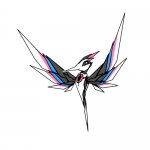 Ok, I admit it; I don’t actually spend all of my time in the command line. All-in-all, I spend very little time in the command line.
Ok, I admit it; I don’t actually spend all of my time in the command line. All-in-all, I spend very little time in the command line.
I’m working on that! Every new bit that I learn makes it easier — and many times faster — to get things done from the command line.
In the meantime, I use multiple applications in the GUI for my everyday tasks, such as text editing.
For normal ever-day GUI text editing on Linux, I use Kate.
Kate is an advanced text editor. It’s name is an acronym for “KDE advanced text editor”.
Kate is developed by KDE, and as such, comes pre-installed on the KDE desktop. It can be installed on other Linux desktops, and there are also versions of Kate available for OS X and Windows.
Kwrite is a lightweight version of Kate, also pre-installed on KDE and available on other platforms.
Features of Kate
The features that I use — and appreciate — the most in Kate are:
Multi-Document Interface (MDI)
Horizontal & Vertical Window Splitting
Support for Plugins
Session Support
Bi-Directional Text Rendering Support
Line Numbers
Syntax Highlighting Support for >180 Languages
Smart On-the-Fly Spell-Checking
Incremental Search, Also Known As “Find As You Type”
Support for Multiline Search & Replace
Regular Expression Support
Overview of Kate
When you first open Kate (via Application Launcher > Applications > Utilities > Advanced Text Editor (Kate) or kate & from the command line) you will see a very standard window, but as will all great applications, there are hidden treasures in the many features available.
I think that by now, we all know how to use a basic text editor — open, type, save, repeat, close — and so I’m not going to bore you with the details.
What I am going to bore you with — wait, what? — are some of the more obscure features that I find the most intriguing.
MDI (Tabs!)
The Multi-Document Interface (MDI) is a fancy name for tabs.
When Kate is running, each new document opened with Kate will not open in a new window, but rather as a new tab in the existing window.
The title of an open file will appear on the Kate equivalent of a tab bar — like a browser.
If more tabs are open than can be reasonably shown in the tab bar, use the “Quick Open” icon on the right of the tab bar to show the list of open tabs.
Splitting Windows
A single Kate window can be split into multiple screens, either horizontally or vertically.
This feature is great for comparing files, working on two files at once, and more.
First, open a single file, then split the screen by selecting either View > Split View or the “Split View” icon on the far right of the tab bar, and selecting a horizontal or vertical split.
The current file will be split, so simply select the screen that you want changed to a new file, and open the new file to fill the selected screen.
Each screen can be split again, and again, and again, but there will come a time when the number of screens becomes more annoying than useful!
To close or “un-split” an open screen, select the screen to close, go to one of the split screen Menu/icon locations and choose “Close Current View”.
Alternatively, you can use the Ctrl + Shift + R keyboard shortcut.
Syntax Highlighting
Syntax highlighting is a feature that displays text in different colors, depending on the syntax, or arrangement, of a written language. Syntax highlighting is often used — and useful! — when programming, etc.
Kate does not automatically recognize languages and provide syntax highlighting for them. It has to be told to employ syntax highlighting for each file, by opening that file and then going to Tools > Highlighting and choosing the language(s) that you will be using.
Mode, Indentation, and Encoding can be adjusted in a similar manner.
Keyboard Shortcuts
Kate’s default keyboard shortcuts are mostly standard, sharing functions and/or similarities to other programs, especially Firefox and Dolphin, both of which I use shortcuts for all of the time.
This makes the most basic shortcuts very easy to remember!
Alt + Right Arrow Next Tab
Alt + Left Arrow Previous Tab
Ctrl + Z Undo
Ctrl + X Cut
Ctrl + C Copy
Ctrl + V Paste
Ctrl + A Select All
Ctrl + F Find
Ctrl + G Go To Line
Ctrl + I Indent
Ctrl + J Join Lines
Ctrl + K Delete Line
Ctrl + U Uppercase
Ctrl + Shift + U Lowercase
Ctrl + N New
Ctrl + O Open
Ctrl + S Save
Ctrl + L Save All
Ctrl + Shift + S Save As
Ctrl + W Close
Ctrl + Q Quit
Ctrl ++ Increase Font Size
Ctrl -- Decrease Font Size
F10 Toggle Dynamic Word Wrap
F11 Toggle Line Numbers
Ctrl + Shift + L Split Screen Vertically
Ctrl + Shift + T Split Screen Horizontal
F8 or Shift + F8 Switch Between Screens
Ctrl + Shift + R Close Current Screen
Conclusion
The picture of the bird at the beginning of this post is Kate, the Kate mascot.
It’s relatively new, in case you haven’t seen it around yet, and don’t see it everywhere right away.
